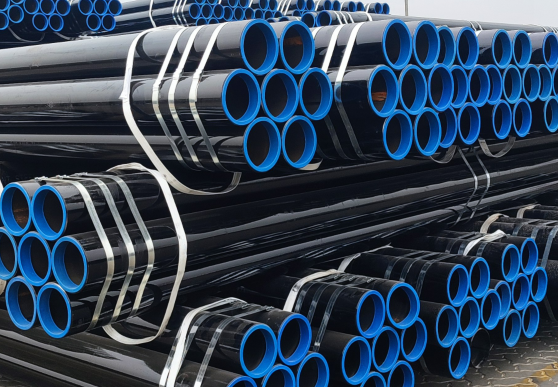
ASTM A53 - Standard Specification for Black and Hot-Dip Galvanized Welded and Seamless Steel Pipe.
ASTM A53 was developed by the American Society for Testing and Materials (ASTM) for carbon steel seamless pipes and welded pipes, which are widely used in the oil, gas, construction, chemical, machinery manufacturing and other industries. ASTM A53 pipe is intended for mechanical and pressure applications and is also acceptable for ordinary uses in steam, water, gas and air lines.
½” – 12” some limitations dependent upon grade. Sizes up to 26” OD are available on limited basis.
Standard Specification for Pipe, Steel, Black and Hot-Dipped, Zinc-Coated, Welded and Seamless. This specification covers seamless and welded black and hot-dipped galvanized steel pipe.

The following types and grades of A53 pipe are covered within this specification:
ASTM A53 Galvanizing Requirements:
ASTM A53 standard specification including hot dipped galvanized (zinc coated) requirements for ASTM A53 Grade B pipe.
Moreover, there are pipe internal and external galvanization. By the hot dip procedures, zinc thickness of any grade shall be complied to specification B6.
Zinc coating weight should be not less than 1.8 oz/ft2, 0.55 kg/m2, and each sample weight shall not be not less than 1.6 oz/ft2 0.49 kg/m2, meanwhile sample outside surface and inside surface weight shall not be less than 1.3 oz/ft2 0.40 kg/m2.
ASTM A53 Applications:
1 Construction industry: structural support (towers) and water heating systems (boilers, hot water transportation and other pipelines with large groundwater extraction.)
2 Machinery manufacturing: hydraulic systems, automotive parts, bearing groups, processing machinery and other accessories.
3 Electrical: gas transmission, hydraulic fluid pipelines.
4 Chemical and power: steam pipelines, boiler systems, anti-static pipes in wind power plants.
5 Oil and gas: oil pipelines, wellhead equipment
Mechanical Properties - Tensile Requirements
| seamless and erw | Grade A | Grade B |
| Tensile Strength, min, psi | 48,000 | 60,000 |
| Yield Strength | 30,000 | 35,000 |
Chemical requirements for ASTM A53
| Seamless and ERW | C max % | Mn max % | P max % | S max % |
| Grade A | 0.25 | 0.95 | 0.05 | 0.045 |
| Grade B | 0.30 | 1.20 | 0.05 | 0.045 |
| Type |
Carbon
max. % |
Manganese max. % |
Phosphorous max. % |
Sulfur max. % |
Copper max. % |
Nickel max. % |
Chromium max. % |
Molybdenum max. % |
||||||||
|
Grade A |
Grade B |
Grade A |
Grade B |
Grade A |
Grade B |
Grade A |
Grade B |
Grade A |
Grade B |
Grade A |
Grade B |
Grade A |
Grade B |
Grade A |
Grade B |
|
|
Type S (seamless) |
0.25 | 0.30 | 0.95 | 1.2 | 0.05 | 0.05 | 0.045 | 0.045 |
0.40 |
0.40 |
0.40 |
0.40 |
0.15 |
0.15 |
0.08 |
0.08 |
|
Type E (electric-resistance welded) |
0.25 | 0.30 | 0.95 | 1.2 |
0.05 |
0.05 | 0.045 | 0.045 |
0.40 |
0.40 |
0.40 |
0.40 |
0.15 |
0.15 |
0.08 |
0.08 |
|
Type F (furnace-welded pipe) |
0.30 | / | 1.2 | / | 0.05 | / |
0.045 |
/ |
0.40 |
/ |
0.40 |
/ |
0.15 |
/ |
0.08 |
/ |
ASTM A53 seamless steel pipe is an American standard brand. A53-F corresponds to China's Q235 material, A53-A corresponds to China's No. 10 material, and A53-B corresponds to China's No. 20 material.
Comparison with other standards:
ASTM A53: general purpose carbon steel pipe, suitable for medium and low pressure fluid transportation
Main difference: divided into A/B grades, seamless or welded
ASTM A106: high temperature and high pressure seamless pipe (≤650°C)
Main difference: only seamless, suitable for steam/oil and gas
API 5L: long-distance oil and gas pipelines
Main difference: more stringent pressure resistance & corrosion resistance requirements
Production process:
ASTM A53 Seamless pipe manufacturing process is divided into hot-rolled and cold drawn seamless pipe.
1. Production process of hot-rolled seamless steel pipe: tube billet → heating → perforation → three-roller/cross-rolling & continuous rolling → de-pipe → sizing → cooling → straightening → hydraulic test → marking → seamless steel pipe with leverage effect detected.
2. Production process of cold drawn seamless steel tubes: tube blank → heating → perforation → heading → annealing → pickling → oiling → multiple cold drawing → blank tube → heat treatment → straightening → hydraulic test → marking → storage.
ASTM A53 ERW welded pipe production process:
Slitting - uncoiling - strip leveling - head and tail shearing - strip butt welding - loop storage - forming - welding - burr removal - sizing - flaw detection - fly cutting - initial inspection - steel pipe straightening - pipe section processing - hydraulic pressure test - flaw detection - printing and coating - finished product.
Straight seam electric resistance welded steel pipe (abbreviated as ERW pipe) has the characteristics of high production efficiency, low cost, material saving and easy automation. The main factors affecting the straight seam resistance welded steel pipe: input heat, welding pressure, welding speed, opening angle, placement of impedance, etc. It is widely used in water supply and drainage projects, oil and gas projects, and can also be used as piling pipes, bridges; docks, roads, building structures, etc.
Conclusion:
ASTM A53 is a widely used carbon steel pipe standard in the world, suitable for welded and seamless steel pipes, providing A/B grade strength options, and supporting galvanized or black pipe treatment. Its good weldability, mechanical properties and dimensional accuracy make it the preferred material for industries such as construction, energy, and machinery. If higher temperature or pressure applications are required, consider ASTM A106 or API 5L.
Read more: ASTM A106 Pipe Specification or Steel Pipe Dimensions & Sizes Chart
